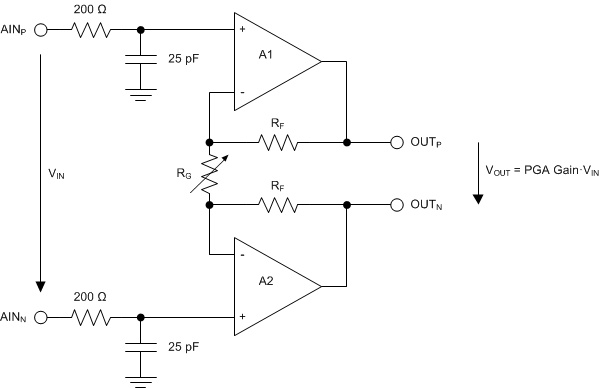JAJSF20B October 2017 – October 2018 ADS122C04
PRODUCTION DATA.
- 1 特長
- 2 アプリケーション
- 3 概要
- 4 改訂履歴
- 5 概要(続き)
- 6 Pin Configuration and Functions
- 7 Specifications
- 8 Parameter Measurement Information
-
9 Detailed Description
- 9.1 Overview
- 9.2 Functional Block Diagram
- 9.3
Feature Description
- 9.3.1 Multiplexer
- 9.3.2 Low-Noise Programmable Gain Stage
- 9.3.3 Voltage Reference
- 9.3.4 Modulator and Internal Oscillator
- 9.3.5 Digital Filter
- 9.3.6 Conversion Times
- 9.3.7 Excitation Current Sources
- 9.3.8 Sensor Detection
- 9.3.9 System Monitor
- 9.3.10 Temperature Sensor
- 9.3.11 Offset Calibration
- 9.3.12 Conversion Data Counter
- 9.3.13 Data Integrity Features
- 9.4 Device Functional Modes
- 9.5 Programming
- 9.6
Register Map
- 9.6.1 Configuration Registers
- 9.6.2 Register Descriptions
- 10Application and Implementation
- 11Power Supply Recommendations
- 12Layout
- 13デバイスおよびドキュメントのサポート
- 14メカニカル、パッケージ、および注文情報
パッケージ・オプション
メカニカル・データ(パッケージ|ピン)
サーマルパッド・メカニカル・データ
- RTE|16
発注情報
9.3.2 Low-Noise Programmable Gain Stage
The device features programmable gains of 1, 2, 4, 8, 16, 32, 64, and 128. Three bits (GAIN[2:0]) in the configuration register are used to configure the gain. Gains are achieved in two stages. The first stage is a low-noise, low-drift, high input impedance, programmable gain amplifier (PGA). The second gain stage is implemented by a switched-capacitor circuit at the input to the ΔΣ modulator. Table 9 shows how each gain is implemented.
Table 9. Gain Implementation
| GAIN SETTING | PGA GAIN | SWITCHED-CAPACITOR GAIN |
|---|---|---|
| 1 | 1 | 1 |
| 2 | 1 | 2 |
| 4 | 1 | 4 |
| 8 | 2 | 4 |
| 16 | 4 | 4 |
| 32 | 8 | 4 |
| 64 | 16 | 4 |
| 128 | 32 | 4 |
The PGA consists of two chopper-stabilized amplifiers (A1 and A2) and a resistor feedback network that sets the PGA gain. The input is equipped with an electromagnetic interference (EMI) filter. Figure 43 shows a simplified diagram of the PGA.
 Figure 43. Simplified PGA Diagram
Figure 43. Simplified PGA Diagram VIN denotes the differential input voltage VIN = VAINP – VAINN. Use Equation 4 to calculate the gain of the PGA. Gain is changed inside the device using a variable resistor, RG.
The switched-capacitor gain is changed using variable capacitors at the input to the ΔΣ modulator. Gains 1, 2, and 4 are implemented by using only the switched-capacitor circuit, which allows these gains to be used even when the PGA is bypassed; see the Bypassing the PGA section for more information about bypassing the PGA.
Equation 5 shows that the differential full-scale input voltage range (FSR) of the device is defined by the gain setting and the reference voltage used:
Table 10 shows the corresponding full-scale ranges when using the internal 2.048-V reference.
Table 10. Full-Scale Range
| GAIN SETTING | FSR |
|---|---|
| 1 | ±2.048 V |
| 2 | ±1.024 V |
| 4 | ±0.512 V |
| 8 | ±0.256 V |
| 16 | ±0.128 V |
| 32 | ±0.064 V |
| 64 | ±0.032 V |
| 128 | ±0.016 V |